It has been exactly 25 years since the first NATO Implementation Force (IFOR) troops arrived in Bosnia and Herzegovina to verify and monitor the military annex of the Dayton Peace Agreement.[1] The NATO force was more heavily armed than any other UN peacekeeping mission had ever been. They also received very different Rules of Engagement (ROE), allowing them to use force not only in self-defence, but also whenever the compliance to the Dayton Agreement was compromised or when parties would try to prevent the IFOR troops from performing their tasks.[2] This article will first give a brief outline of some security and force protection issues peacekeepers had to deal with during the UNPROFOR (UN Protection Force) mission, pointing out why these new integrated security measures in the NATO operation were deemed necessary. Then, the article will answer the question which measures were taken and which conditions were set out by the Dutch government to increase the troops’ security prior to their participation in IFOR. It concludes with a short reflection on these developments.
Elke Boers MA MSc*
There were many reasons to move from a UN peacekeeping arrangement to a NATO peace operation by the end of 1995, all of which were related to the lack of security for the peacekeepers and civilians during the Bosnian armed conflict between 1992 and 1995. The UNPROFOR mission, authorized by the UN Security Council in February 1992 and sent to Croatia and Bosnia to prevent further escalation of the conflict in the former Yugoslavia, was meant to create an environment to conduct peace negotiations and to facilitate humanitarian action. Only, as is so often cited in the literature, there was no peace to keep.[3]
As the armed conflict in Bosnia intensified, it became clear that the UN peacekeepers’ presence did not have a deterrent effect on the warring parties. The local population, humanitarian workers and the peacekeepers themselves were attacked or put in danger multiple times. Force was used a couple of times by the UNPROFOR troops in self-defence, to safeguard humanitarian operations or to protect civilians — though only when the national commander interpreted the mandate as such and decided to act if the troops had enough capability.5 Moreover, there was also the realization that acting in a more robust manner could have severe implications for the humanitarian convoys or other peacekeepers, like the unarmed UN military and European Union (EU) observers.
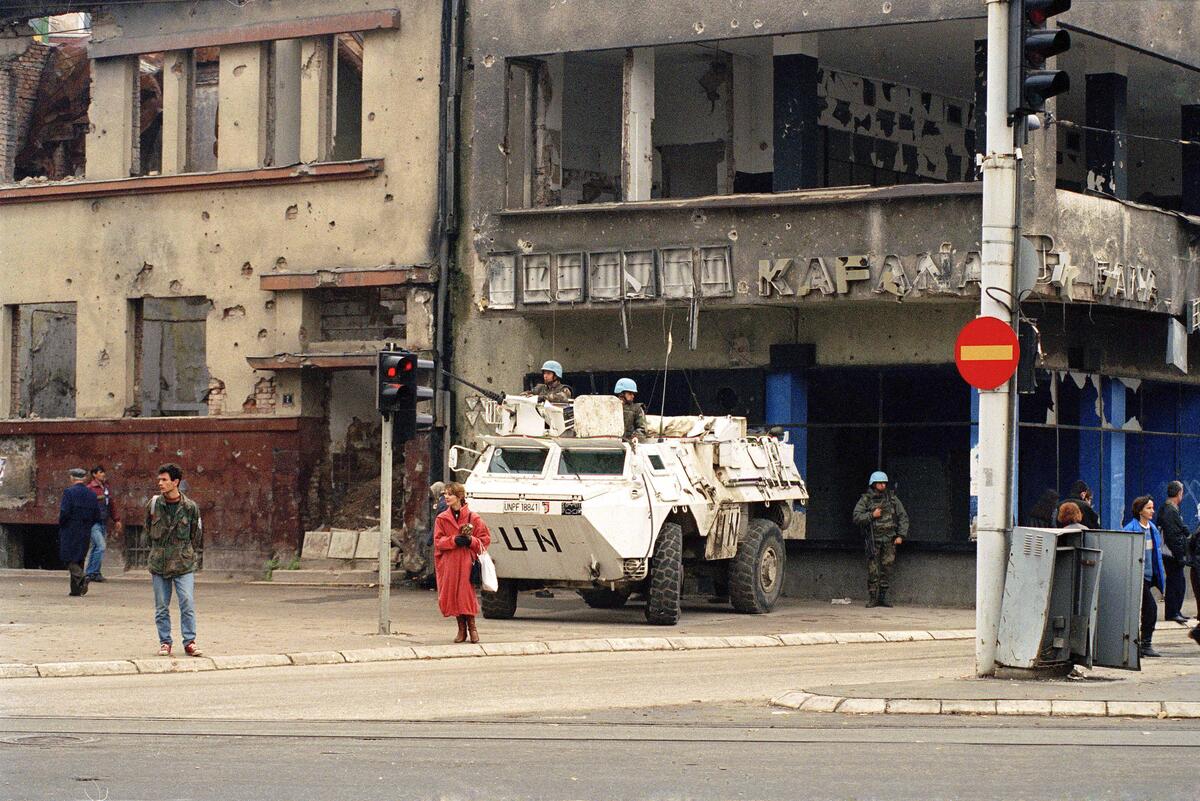
UN peacekeepers patrol the streets of Sarajevo during a visit of UN Secretary General Boutros-Ghali to the Bosnian capital in November 1994. Photo UN
The same realization had refrained the international community from allowing their peacekeepers to take a more robust stance. Especially the European governments, which had a lot of boots on the ground, had been anxious about ending up in a full-blown conflict[4] or were afraid for retaliation. So when the term safe area[5] was first introduced in 1993, after Bosnian Serb forces had again besieged several towns, the term safe haven was intentionally avoided as it had a specific meaning and entailed specific obligations under international law which went beyond the concept of safe area.[6] The chosen term safe area did not entail any obligation or mandate to protect a safe area with military means. So even when the Markale market in the safe area Sarajevo was shelled in February 1994, killing 68 people and injuring 144, no far-reaching decisions regarding the use of force could be made.[7]
It would take until 10 and 11 April 1994 for UNPROFOR to call in air strikes and for NATO to act to protect the Gorazde safe area. It was the first time in its history that NATO would attack ground targets with aircrafts. Subsequently, though, just as the international community had feared, the Bosnian Serbs took 150 UN peacekeepers hostage. The same would happen a year later, on 25 and 26 May 1995, when NATO decided to carry out airstrikes on Bosnian Serb ammunitions depots in Pale after the Bosnian Serbs had violated the exclusion zones and shelled other safe areas. 370 UN peacekeepers and military observers were taken hostage and used as human shields. It would take several more months, until the Markale market suffered another attack with five mortar shells on 28 August, killing 43 people and wounding 75 others, that retaliation became inevitable and the NATO Secretary-General announced the start of Operation Deliberate Force.[8]
Operation Deliberate Force, starting on 30 August 1995, would become NATO’s largest combat undertaking since the Alliance was founded in 1949. At the same time, the limited character of the bombings was emphasised. NATO pilots were tasked to only attack crucial military targets, mainly with the aim to damage the air defence systems and certainly not to ‘bomb out’ the Serbs or destroy the Bosnian Serb Army. Only by mid-September did the commanders in charge (General Bernard Janvier and Admiral Leighton Smith) note a more substantial withdrawal of the Bosnian Serb heavy weapons around Sarajevo. On 20 September 1995 NATO and UN announced the indefinite suspension of Operation Deliberate Force.[9]
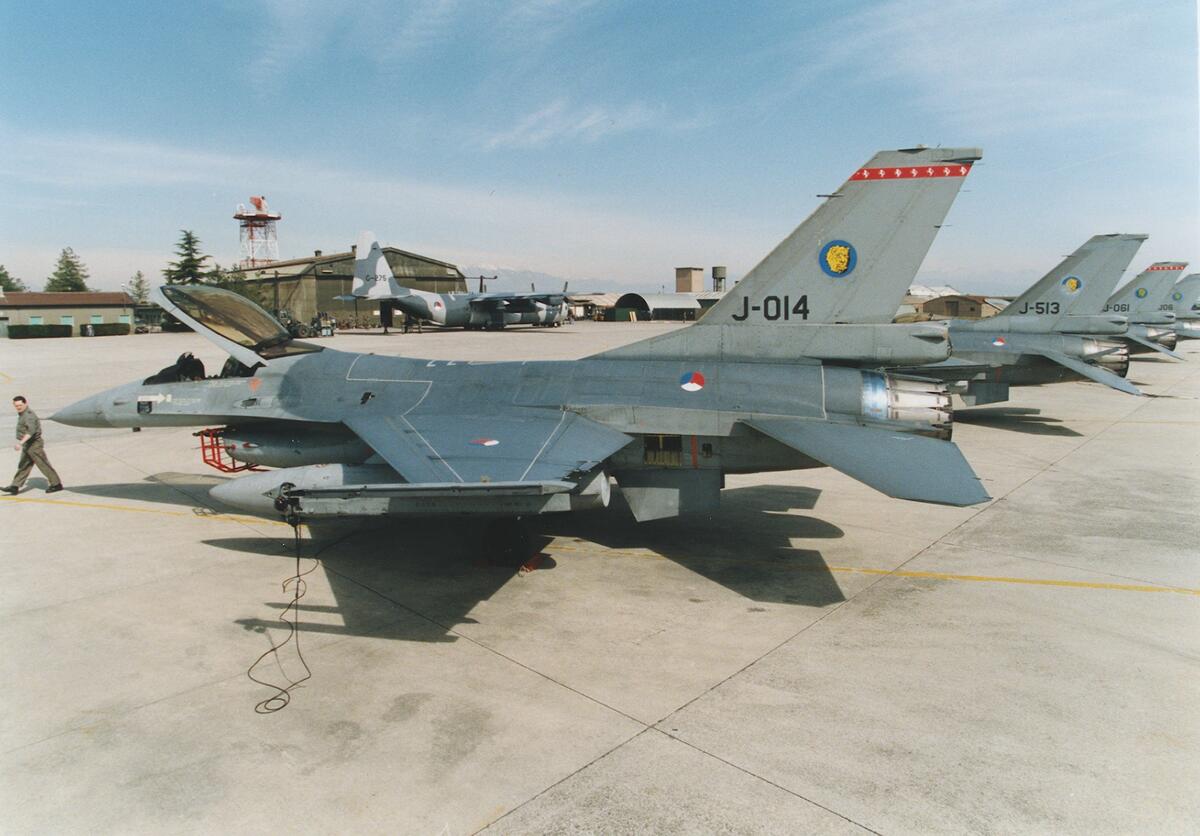
From Villafranca in Italy the Royal Netherlands Air Force took part in NATO Operation Deny Flight (1993-1995) which was tasked with the enforcement of a UN no-fly zone over Bosnia and Herzegovina. Photo Beeldbank NIMH
As a result, (some of) the former warring parties who had signed the Dayton Agreement were literally forced to the negotiating table in Ohio a month later. It was clear that by then, the international community had taken a more robust stance towards the armed conflict in Bosnia and was not willing to turn a blind eye to the atrocities and war crimes anymore. Their intent was to set up a more robust military crisis response operation. This was also true for the Netherlands, even though at the end of August it was not clear yet what exactly had happened in Srebrenica.[10]
Dutch conditions for participation in IFOR
In September 1995 it became painfully clear to UN Secretary-General Boutros Boutros-Ghali that the UN was not well-equipped to manage large-scale crisis response operations. Especially those established under Chapter VII, he concluded, were difficult to manage. Some of the reasons for this were the failure of Member States to pay their assessed contributions on time and the difficulties of coordinating the operations of military personnel and civilian personnel with different mandates and different chains of command. Often (such as in the case of the safe areas) Member States would only deliver a fraction of the troops that were needed to fulfil the mission. The most viable option would be that the UN Security Council might from then on authorize interested and willing Member States, assisted by regional organisations or ad hoc arrangements, to undertake both the military and the civilian aspects of this task.[11]
NATO had already been preparing for a peace operation in Bosnia and Herzegovina for months — in fact, it already had its operational concept for the IFOR mission ready on 11 October 1995. When NATO approached the Netherlands with the question if the Netherlands wanted to contribute to the new IFOR mission, and with how many troops, it was definitely not a question of if, but of how many. It had always been clear, no matter what, that the Dutch government would deploy troops to guard the international order and human rights. Even when in June 1995 three Dutch UN observers were finally released after they had been taken hostage, the government was still of the opinion that it had to make an effort to make this ‘important humanitarian mission’ succeed. Withdrawing its forces, in the cabinet’s opinion, would not only cause great risks for the UN troops, but also further damage the international legal order.[12]
Even though the Dutch Parliament was also in principle in favour of renewed participation, it was none too pleased when it heard that the Dutch government had already made a provisional offer to NATO without consultation. Not only did the fact that the Parliament had not been involved caused quite a stir in the Parliament, it also was still not clear what exactly had happened in Srebrenica. Its Members, however, recognized that there was still a lot of support, also from the Dutch public, to continue contributing to the international peace efforts in Bosnia and Herzegovina.[13] Of course, there were some requirements attached to participation.
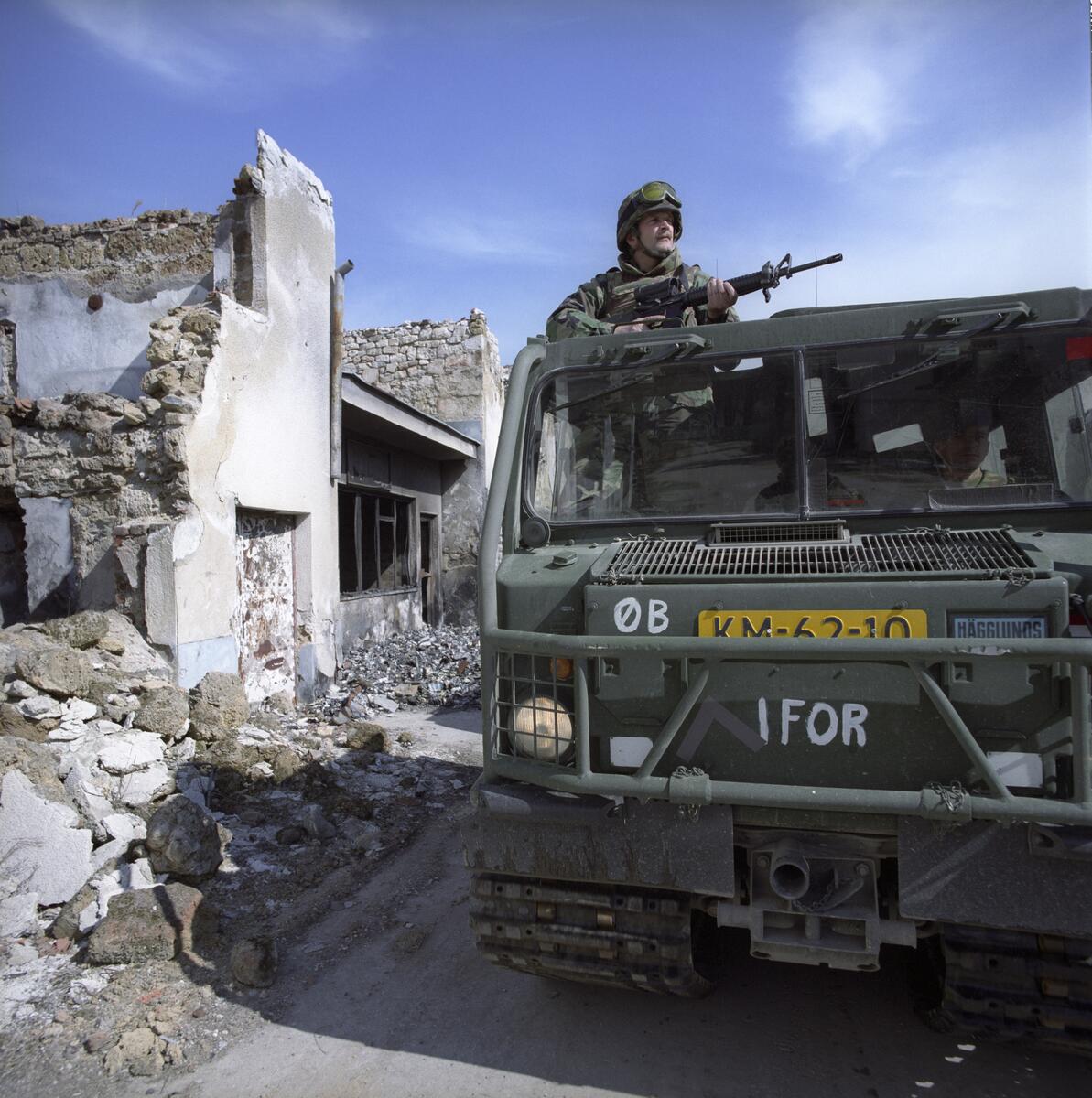
Dutch marines drive through a severely damaged Bosnian village during the IFOR mission. Photo Beeldbank NIMH
On 4 October 1995, the government had already planned with the armed forces command the possible contributions to the new IFOR mission. They concluded that they wanted to contribute their ‘fair share’, which then resulted in the proposal for a mechanized battalion (Mechbat), a special forces unit,[14] possibly an F-16-squadron (which was at that moment part of Operation Deny Flight), a mortar company and a counter-battery radar (which were also operational as part of the in-theatre Rapid Reaction Force) and a logistical battalion (which was already a part of UNPROFOR).[15] This offer largely remained the same and had not been altered to a great extent by December. The mechanized battalion would in the end consist of two armoured infantry companies, a tank company and support and combat support elements. The F-16s and the mortar company would also be part of the Dutch contribution, together with a transport aircraft and two more F-27s for medical evacuations.[16] Whilst the troop contribution was comparable to that of UNPROFOR, the military was this time going to be far better equipped for possible confrontations.
During a parliamentary debate on 5 September Dutch Minister of Defence Joris Voorhoeve agreed to look at possible improvements in the military control of peace operations and the internal information provisions and policy advice regarding such operations. On 20 October, he wrote a letter which looked at previous peacekeeping experiences. It is also remarkable how a comparison was made with the military control in Canada and Norway — exactly because these countries also gave extensive support to peace operations. The UK was added to this comparison because the Netherlands had a long tradition in cooperation with the UK, as was the case with Germany.[17] This exercise, together with the previous Dutch experiences during UNPROFOR, resulted in some conditions that had to be met before the Dutch government would send out troops for the IFOR mission. These conditions can be categorised into three more general topics: I) a clear mandate, a clear chain of command, and better information provision, II) a more robust mission with more elaborate Rules of Engagement (ROE) and III) a mission which was embedded into an international alliance with stronger alliance partners.
A clear mandate and better information provision
One of the most cited reasons for the partial failure of the UNPROFOR mission was that there was no clear mandate and no decent information provision between military units from different countries or between the different missions. The dual-key system also prevented that decisive actions could be taken on time. One of the main frustrations of the national commanders who had participated in UNPROFOR was that their mandate was so vague that they were forced to give it their own interpretation — with many different outcomes as a consequence. Therefore, one of the main requirements for the new mission, both for the US and for other countries like the Netherlands, was that the mandate and the tasks had to be clear[18] and enforceable for the military.[19]
IFOR would indeed receive clear and concrete military tasks pertaining to the implementation of the territorial and militarily related provisions of the Dayton Agreement. The IFOR soldiers had to verify if all the parties were complying with the cessation of hostilities and withdrawing all their foreign forces. IFOR would supervise demarcation lines and monitor the withdrawal of the warring parties from these ‘inter-entity’ borders and guard the zone of separation in between. They would also have to ensure the protection of the withdrawing UNPROFOR troops. Both the Bosnian entities (the Serb Republic and the Bosnian-Croat Federation) were then equally subject ‘to such enforcement action by the IFOR as may be necessary to ensure implementation of this Annex and the protection of the IFOR’.[20] Only when circumstances would allow could the troops give support to the humanitarian activities. [21]
Voorhoeve made it clear that the focus of IFOR was to ensure the compliance to the military annex — and that they could enforce it, if necessary. Their task was to create favourable circumstances for the necessary reconstruction of Bosnia, not to provide the humanitarian relief efforts to the population and organise elections. In contrast to other peacekeeping missions, these non-military tasks were left to the specialized agencies and organisations. The civil aspects of the reconstruction were put in the hands of the UNHCR, the OSCE, the European Union, the World Bank and the UN High Commissioner for Human Rights.[22]
Parallel to the single command structure (without the risk of a dual-key system), the Netherlands would also implement a new information provision structure within its own national system. This resulted in a new role for the Chief of Defence and the establishment of the Contingency Command, whose main task was to be in direct contact with the Chief of the Defence Staff (CDS) and the Dutch ministers to ensure a solid information flow.
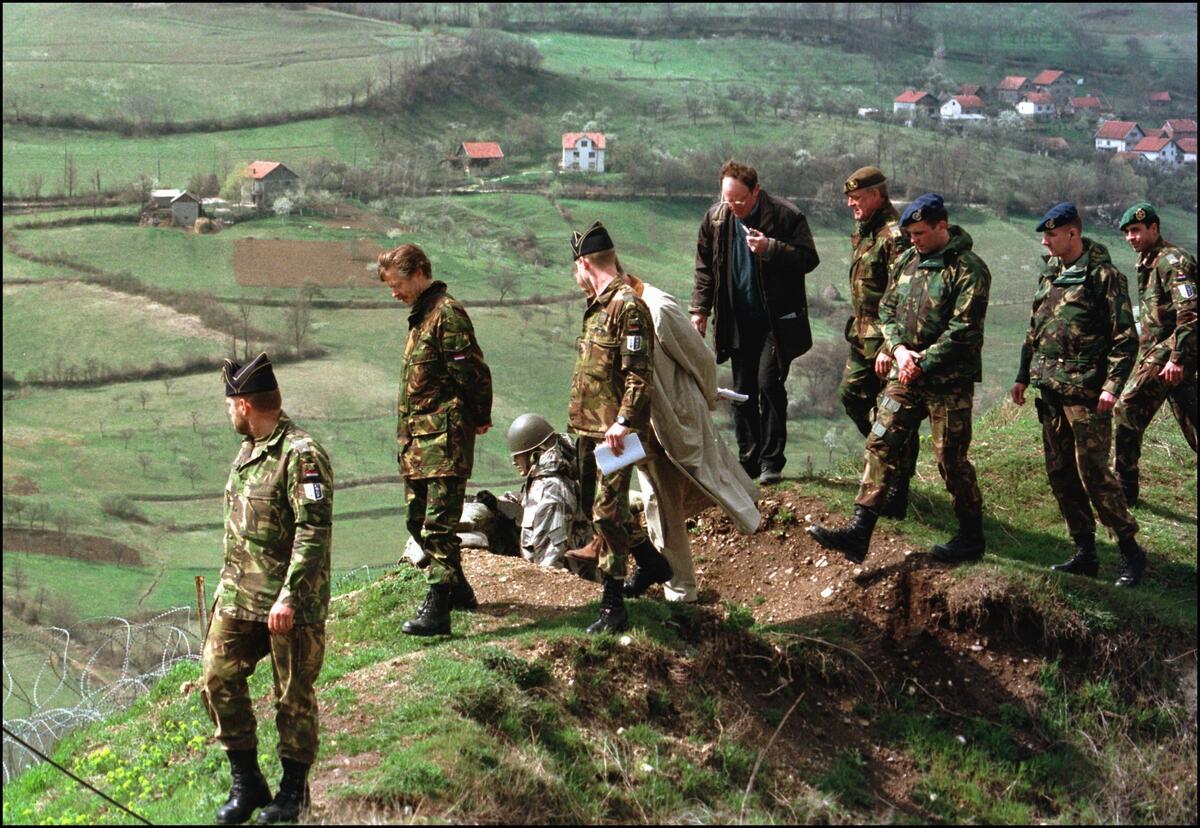
Dutch Defence Minister Joris Voorhoeve (second from the left), seen during a later visit to Bosnia, insisted that words would have to be backed by means during the IFOR mission. Photo Beeldbank NIMH
Whereas previously the command and control would be laid solely with the section of the armed forces the dispatched unit(s) belonged to (as in Cambodia), the immediate responsibility was now given to the Chief of Defence for all matters regarding peace- and crisis management operations. Additionally, the plan was that a Dutch national contingency command would be added to the British Division’s headquarters in Gornji Vakuf,[23] so from there on information could be communicated directly to the Chief of Defence. The liaison command would make sure that the Dutch government would always be well-informed of ongoing developments in the area of operations. Voorhoeve hoped to improve the operational control and information provision with these measures.[24]
Another change was that the Deputy Head of Operations could use the crisis management centre to plan and prepare for future missions. Clear guidelines were drawn up for future evaluation reports and debriefings.[25] All this was done to ensure that information was passed through more efficiently and that the government would be informed of important developments in the Area of Responsibility in a more timely manner.
Risks, robustness and ROE
Another requirement was that robust Rules of Engagement had to be in place. One of the main concerns during UNPROFOR had been the peacekeepers’ lack of effectivity and deterrence. Already in December 1994 national CDSs had gathered in The Hague to discuss the possibilities of improving the effectivity of blue helmets and guaranteeing their safety. Not only were the CDSs, but also representatives of the UN secretariat and NATO.[26] However, as the mission was restricted by the peacekeeping principles, no far-reaching decisions were made.
his lack of a deterring effect had been a main criticism not only from the Netherlands, but also from the international community. In 1995 this had become one of the most pressing issues, as the Bosnian Serbs had begun to overrun several safe areas, among which Srebrenica (and the Dutch forces’ blocking positions). The Bosnian Serb commander General Ratko Mladic had even threatened to kill 30 Dutch soldiers who were being retained.[27] The Dutch parliament was decisive — albeit that this debate came too late — that something had to be done to increase the UN troops’ ability to defend themselves and to improve the humanitarian help provided to the population.[28]
These experiences convinced the entire international community that the NATO operation had to receive more robust ROE and could bring more heavy weapons to protect themselves and the local population. Also, in the Netherlands, Voorhoeve recognised that, again, there would be many risks tied to this mission.[29] Moreover, he acknowledged that they were strongly determined by the willingness of the parties to execute the peace agreement — and that this willingness was not an automatic given. Indeed, the Presidents of Serbia, Croatia and Bosnia committed themselves to cooperate with IFOR and guaranteed the security of the IFOR military, but that was not to say that the troops could not expect any local armed resistance. In Voorhoeve’s opinion, IFOR had to be prepared for such actions. As Mechbat was going to be deployed in the northwest of Vitez, where the Bosnian-Croat Federation had to return territory to the Bosnian Serbs, these risks could not be downplayed.[30]
Therefore, the troops would not only be more heavily armed — they would also be allowed to use offensive force, if necessary. As Voorhoeve stated: ‘the best way to limit the number of victims is to show them from the beginning that these units cannot be trifled with. In this sense, the heavy armament and the robust set-up is in all likelihood the best measure to keep the risks as limited as possible, and, at the same time, to increase the chance of compliance with the IFOR-arrangements as much as possible.’[31] The division and national commanders even received the permission to use landmines for protection and self-defence. The Dutch Chief of Defence, however, assessed that the use of landmines to protect Dutch units was not necessary and definitely a bridge too far. According to him, the situation in Bosnia was stable enough, so there was no necessity to use this measure. Consequently, the Dutch units would not bring anti-tank or anti-personnel mines with them to their Area of Responsibility.[32]
With an explicit reference to Srebrenica, Voorhoeve further explained how the IFOR operation would differ from the UNPROFOR mission. The battalion would guard the division line in the northwest of Vitez (in the area of Jajce and Donji Vakuf), but, in contrast to Dutchbat in Srebrenica, they would not man observation posts.[33] Instead, teams would patrol along the demarcation line and the area. Three teams would then be formed in the battalion, which could take turns in patrolling. Every team would patrol with tanks, YPR armoured vehicles and anti-tank systems. Rather than occupying observation posts, the more mobile and concentrated actions would diminish the chance of being taken hostage.[34]
These feelings were definitely shared by the other troop contributing countries and the higher levels of command. Admiral Leighton Smith, for example, would make sure to demonstrate very early on in the operation that IFOR was very different from its predecessor. This was accomplished within hours of the transfer of authority by IFOR forces knocking down checkpoints and crossing the former confrontation lines into Serb-held areas into which UNPROFOR had previously not been allowed to venture. As Smith would later say in an interview: ‘Force protection was a top priority and we would act decisively should our forces be threatened.’[35]
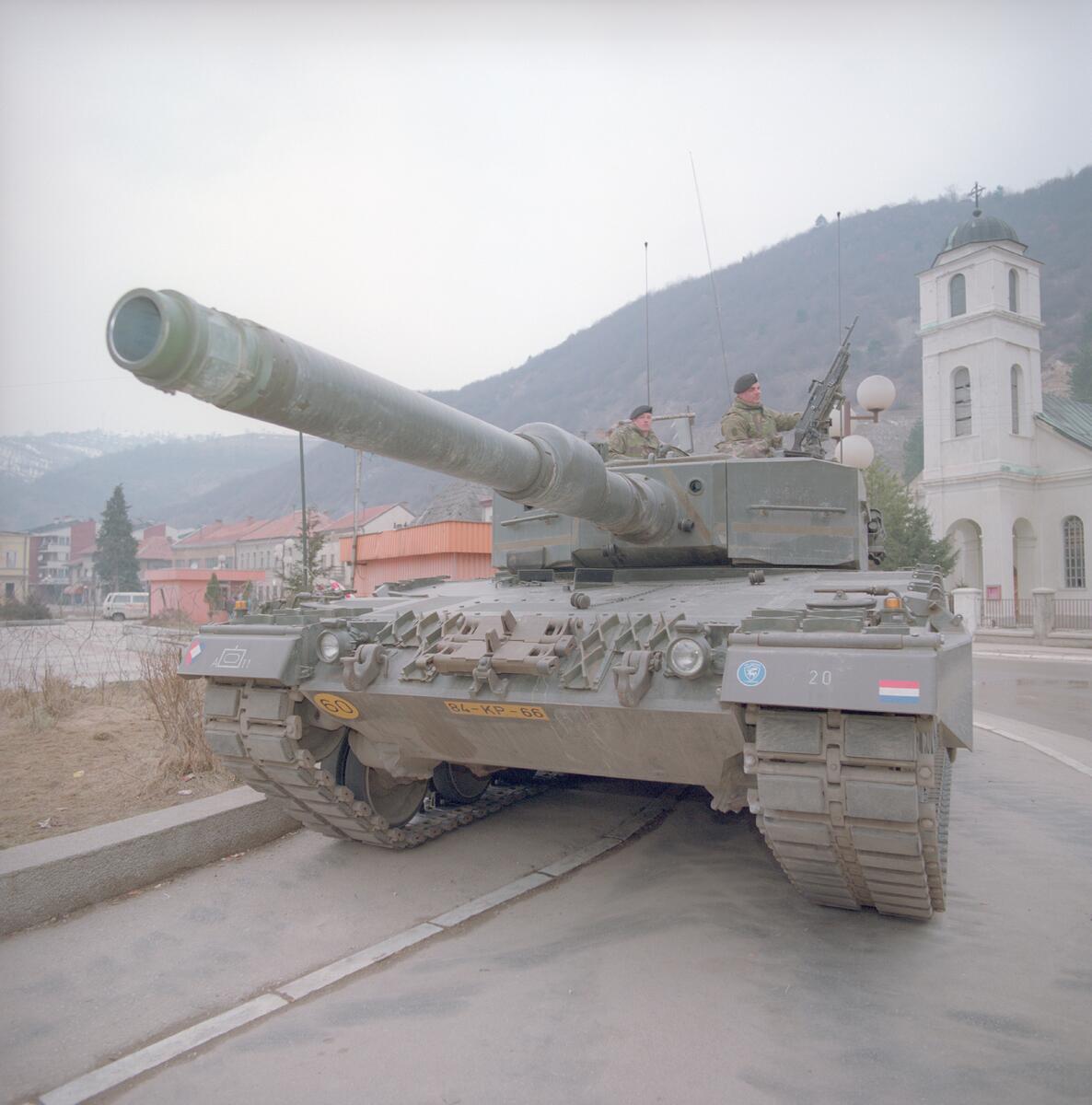
A Dutch Leopard-2 combat tank near Donji Vakuf, Bosnia. Force protection was a top priority for IFOR. Photo Beeldbank NIMH
Operating within a coalition and with strong alliances
In the wake of the then recent Srebrenica massacre, there was also a strong consensus that if Dutch troops would again be sent to Bosnia and Herzegovina the operation had to be firmly embedded in a NATO operation or in a coalition[36] with one of the bigger troop-contributing countries. [37] There were several reasons why this set-up had their preference.
One reason was that the Dutch — much like any other military unit during UNPROFOR — were left to their own devices when Srebrenica was overrun. Operating under NATO command with an extensive American presence on the ground was a reassuring thought to the Dutch Cabinet and Parliament. NATO could fulfil the promise of ‘allied solidarity’,[38] which meant that the Netherlands would never be operating alone, as its forces had experienced during the Srebrenica crisis.
Voorhoeve would explain this point of view more into detail in an article for the Los Angeles Times Syndicate, stating that nations had to provide the force with the military means necessary to execute IFOR’s mandate. He stated that ‘words have to be backed by means. The dramatic failure of the implementations of the UN safe area concept in Bosnia was largely due to the fact that only some 5,000 of the necessary 34,000 troops were provided. The implementation force should have escalation dominance by being able to count on NATO air power. There is a simple rule in the use of military power. If one wants to limit casualties, one has to move in a force that is strong enough to deter attacks.’[39]
Moreover, NATO could guarantee that it always had enough military units at its disposal to fulfil the tasks and to have escalation dominance at all times. Throughout the UN peace mission the severe deficit in troop contributions from the UN Member States had been an issue. NATO, therefore, made sure that participation from as many countries as possible would ensure sufficient troop contribution to fulfil the tasks ahead — as this had hardly ever been the case during the previous UN peacekeeping missions. It issued an arrangement which allowed non-NATO countries to participate. As a result, a significant number of non-NATO countries joined IFOR.[40]
Thirdly, the Netherlands wanted to avoid at all costs that it was going to operate alone and without a strong ally in theatre. Therefore, the Netherlands tied its presence to the presence of both the UK and the US. Especially the presence of the US was important to Voorhoeve. According to him, US participation and leadership would not only inspire confidence in the endeavour; it was also in some way their duty as ‘leader of the alliance’. Moreover, he wondered what the message would be to the warring parties if the US would not take its share in implementing the agreement it had brokered itself.[41]
This condition went so far that the cabinet had linked its participation irreversibly to the British troop presence, as the Dutch units would be operating in the British Multi-National Division South-West. The British, in turn, had linked their presence to American participation. These allied support arrangements were more than enough reassurance for most Members of Parliament, but a motion by MPs Jaap de Hoop Scheffer and Eimert van Middelkoop tried to push this arrangement even further.[42] They wanted to link the Dutch presence directly to the American presence in theatre. In case of an American withdrawal, the Dutch could then also easily withdraw. The motion, however, was deemed unnecessary by a majority and rejected one day later.[43]
Eventually, it was made sure that the Dutch mechanized battalion (with an estimated size of 800 troops) was going to be placed under the operational command of the 4th British Brigade. Especially the fact that this brigade had gained experience during the Gulf War and the war in Bosnia had to take away any remaining doubts. Besides, the Dutch battalion would also be provided with heavy arms, so it could also fulfil its tasks in more difficult circumstances. 14 Leopard-2 tanks with 120mm canon, 22 YPR armoured vehicles mounted with a heavy anti-tank weapon system, 24 portable mortars and 4 heavy mortars, would accompany the Dutch forces on the mission.[44]
Conclusion
The experiences during UNPROFOR led to the realization that it was difficult to let two crisis management agents with different roles — UNPROFOR as a non-threatening peacekeeper and NATO as protector and enforcer — operate alongside each other, without giving the impression of being unbiased. IFOR, UNPROFOR’s successor, would ultimately receive a clear peace enforcement mandate under Chapter VII, and much stronger ROE than any UN force had ever been given. It was then a testament of its effectiveness that IFOR, probably due to the Dayton Peace Agreement and its mandate to use force when necessary, ultimately ended up in much less precarious situations and in a less hostile environment than UNPROFOR.[45]
In the Netherlands, despite the disillusioning experiences during the UNPROFOR period and despite the fall of Srebrenica in the presence of Dutch peacekeeping forces, there still existed substantial parliamentary, governmental and societal support to keep contributing to the IFOR mission in the Bosnian stabilisation campaign.[46] This support and contribution, however, came with several conditions (sometimes explicit because of the experiences in Srebrenica), which were ultimately met through innovative national and allied arrangements. Many of these would remain essential conditions for Dutch participation in future (peace) missions.
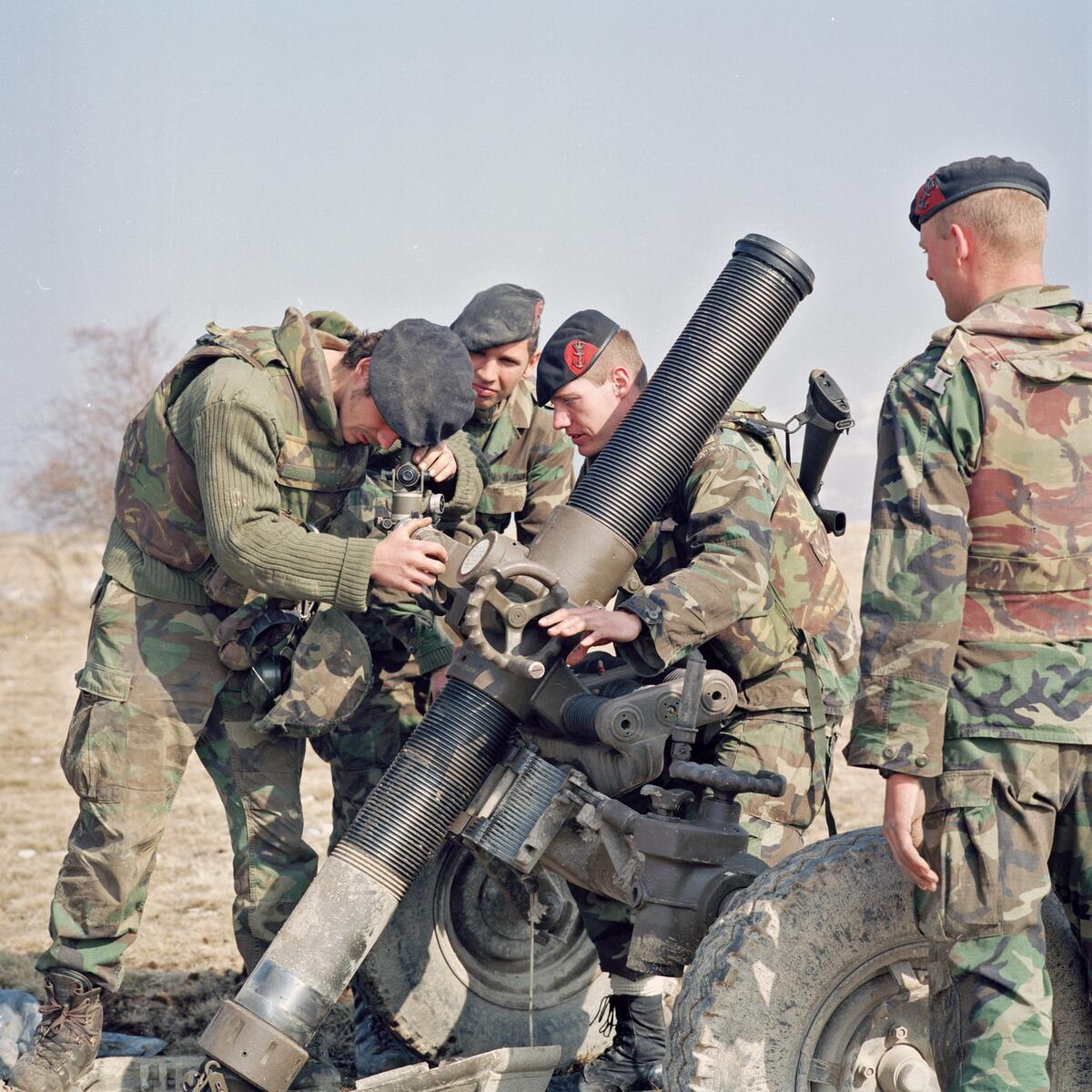
Dutch marines operate a 120mm heavy mortar near Novi Travnik in Central Bosnia in 1996. Photo Beeldbank NIMH
The Dayton Agreement also led to two diverging developments: on the one hand, a lot more international effort was put into creating ‘sustainable peace’ and, on the other hand, the NATO troops received more robust ROE which would even allow them to use force in case the parties would not comply with the Dayton Agreement. Because of this focus on ‘robustness’, IFOR had in essence become a ‘green’ mission, as opposed to the blue UN peacekeeping missions. It is also during this mission that NATO moved from a collective defence towards a collective security organisation and where the practice of more intensified and tougher peacekeeping practice started: IFOR would become the first of a new generation real peace enforcing crisis response operations.
The concept of ‘sustainable peace’ also saw the merging of development issues with security. The assumption that the challenges facing an unstable country needed to be dealt with in a holistic and integrated manner to achieve sustainable peace made for an awkward relationship between military and non-military threats. IFOR soldiers, especially from the middle of 1996, would be with the protection of civil agencies organising the elections, protecting displaced persons and refugees who wanted to return home, and rebuilding infrastructure, just to mention a few examples. Because of IFOR a concrete interpretation was now given to ‘wider peacekeeping’ and the foundations of an allied ‘comprehensive approach’ were laid out.
* Elke Boers currently pursues a PhD at the University of Groningen/Netherlands Institute of Military History. She holds an MA in Slavic Studies (University of Leuven) and an MSc in International Relations (University of Antwerp) and previously worked in Brussels as a researcher for the Horizon2020-funded project El-CSID.
[1] For articles on the Dayton Peace Agreement, see: Michael Dziedzic, ‘The Dayton Accords and Bosnia’s parallel power structures. Impact and security implications’, and Sipke de Hoop, ‘Tussen Dayton en Brussel. Terugkijken op 25 jaar vrede bouwen in Bosnië’, both in: Militaire Spectator 189 (2020) (12).
[2] NATO, ‘Oplan nr. 27 van de bevelhebber der landstrijdkrachten IFOR; ROE’s: E1-1’, archief NIMH 1995-1996, Dossiers [bevelen, orders, plannen] operatieplannen algemeen deel 4.
[3] For a more in-depth analysis of the issues the peacekeepers struggled with during UNPROFOR, see for example Dion Landstra, ‘NIMH College-Joegoslavië: VN onder vuur?’ See: https://www.youtube.com/watch?v=4p6leUWuYys.
[4] Douglas Hurd, Memoirs (London, Abacus, 2004) 502-506; Trevor Findlay, SIPRI report: The Use of Force in UN Peace Operations (Oxford, Oxford University Press, 2002) 263.
[5] UN Security Council Resolution 819, 16 April 1993. The initial definition of safe area entailed that it was ‘free from attack and other hostile acts’.
[6] Findlay, The Use of Force in UN Peace Operations, 227.
[7] One of the reasons being that many European countries (especially France) had too many boots on the ground and could not risk retaliation.
[8] Arthur ten Cate and Martijn van der Vorm, Callsign Nassau (Leiden, Leiden University Press, 2016) 77.
[9] Dick A. Leurdijk, The United Nations and NATO in Former Yugoslavia (The Hague, Netherlands Atlantic Association, 1996) 80-82.
[10] Kamerstuk 22181, nr. 115, 28 August 1995. At that time, it was only clear that the Bosnian Serbs had besieged and overrun Srebrenica. The scale of the Srebrenica genocide was underestimated and not confirmed yet as observers were not allowed into the area. The reconstruction of the events would take many more years.
[11] Letter Boutros-Ghali, 19/09/1995, Semi-Statisch Archief Rijswijk, Archief Missies (052-2738).
[12] Kamerstuk 22181, nr. 103, 23 June 1995.
[13] Merit Guldemond, Srebrenica Voorbij? Het parlementaire en publieke debat over de Nederlandse bijdrage aan IFOR in Bosnië, BA-thesis, 3 June 2016, Leiden University.
[14] In Dutch: mariniers.
[15] Memorandum ‘Nederlandse Militaire Deelname aan IFOR, 4 October 1995, Rijswijk 218.
[16] Kamerstuk 22181, nr. 137, 9 December 1995.
[17] Letter from Defence Minister Voorhoeve to the Chairman of the Parliament, ‘Aansturing van crisisbeheersings-, vredes- en humanitaire operaties’, 20 October 1995, Semi-Statisch Archief Rijswijk, Archief Missies (052-217).
[18] Some of these requirements were also directly derived from the assessment framework that had been drawn up by the Parliament on peacekeeping missions. Letter AVV, ‘Nederlandse Deelname aan IFOR: tussentijds advies van de AVV’, 7 December 1995, Semi-Statisch Archief Rijswijk, Archief Missies (052-218).
[19] Letter AVV, ‘Nederlandse deelname aan IFOR, 7 december 1995, Rijswijk 218.
[20] The General Framework Agreement for Peace in Bosnia and Herzegovina, initialled in Dayton, 21 November 1995, signed in Paris, 14 December 1995.
[21] Memorandum DAV to the Minister, ‘IFOR’, 24 November 1995. Rijswijk 218.
[22] ‘Antwoord van de minister van Defensie tijdens het algemeen overleg met de commissies voor Buitenlandse Zaken en Defensie’, 30 November 1995. Rijswijk 218.
[23] Though this ultimately did not happen, as the contingency command was stationed in a Dutch camp in Busovaca.
[24] Kamerstuk 22181, nr. 137, 9 December 1995.
[25] Letter L. Kroon to the Minister and Secretary of State, ‘Lessons Learned UNPROFOR’, Rijswijk 2734.
[26] Kamerstuk 22181, nr. 94. 4 May 1995.
[27] Kamerstuk 22181, nr. 109, 27 July 1995.
[28] Kamerstuk 22181, nr. 105, 29 June 1995.
[29] Apart from direct threats from local parties, the most severe threats came from landmines and the local population’s driving style and road infrastructure.
[30] Antwoord van de minister van Defensie tijdens het Plenair debat, 12 december 1995. Rijswijk 218.
[31] Handelingen Tweede Kamer 1995-1996, nr. 37, 12 December 1995, 2939-2977.
[32] Letter ‘Gebruik mijnen ten behoeve van zelfbescherming Nederlandse eenheden bij IFOR’, H.G.B. van den Breemen, 1 December 1995. Rijswijk 218.
[33] In Srebrenica, Dutch forces had faced provocation as the observation posts were often fired upon. See Ten Cate and Van der Vorm, Callsign Nassau, 73-75.
[34] Antwoord van de minister van Defensie tijdens het Plenair debat, 12 december 1995. Rijswijk 218.
[35] Admiral Leighton W. Smith, ‘The pillars of peace in Bosnia’, in: NATO Review 44 (1996) (4) 11-16. See: https://www.nato.int/docu/review/1996/9604-3.htm.
[36] At NATO HQ, the concept of ‘Combined Joint Task Forces’ is devised.
[37] ‘ Chronologisch overzicht’, Semi-Statisch Archief Rijswijk, Archief Missies (052-217).
[38] Kamerstuk 22 181 nr. 137, 9 December 1995.
[39] Joris Voorhoeve, ‘Peace in Bosnia: The challenge to NATO’, article for Los Angeles Times Syndicate, 7 November 1995. Shortened version presented to the Ministers. Rijswijk 218.
[40] Ineke Deserno, ‘NATO on IFOR’, 5 January 2016. See: https://www.nato.int/nato_static_fl2014/assets/pdf/pdf_2016_01/20160105_160105-ifor-book.pdf.
[41] Voorhoeve, ‘Peace in Bosnia: The challenge to NATO’.
[42] Guldemond, Srebrenica Voorbij.
[43] Handelingen Tweede Kamer 22181, nr. 38, 13 December 1995.
[44] Antwoord van de minister van Defensie tijdens het Plenair debat, 12 december 1995. Semi-Statisch Archief Rijswijk, Archief Missies (052-218).
[45] Findlay, The Use of Force in UN Peace Operations, 264.
[46] ‘Chronologisch overzicht’, Rijswijk 217.